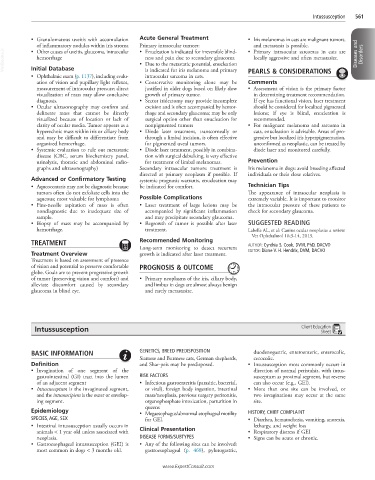Page 1124 - Cote clinical veterinary advisor dogs and cats 4th
P. 1124
Intussusception 561
• Granulomatous uveitis with accumulation Acute General Treatment • Iris melanomas in cats are malignant tumors,
and metastasis is possible.
of inflammatory nodules within iris stroma Primary intraocular tumors: • Primary intraocular sarcomas in cats are
VetBooks.ir Initial Database • Due to the metastatic potential, enucleation locally aggressive and often metastasize. Diseases and Disorders
• Enucleation is indicated for irreversible blind-
• Other causes of uveitis, glaucoma, intraocular
hemorrhage
ness and pain due to secondary glaucoma
intraocular sarcoma in cats.
• Ophthalmic exam (p. 1137), including evalu- is indicated for iris melanoma and primary PEARLS & CONSIDERATIONS
ation of vision and pupillary light reflexes, • Conservative monitoring alone may be Comments
measurement of intraocular pressure; direct justified in older dogs based on likely slow • Assessment of vision is the primary factor
visualization of mass may allow conclusive growth of primary tumor. in determining treatment recommendation.
diagnosis. • Sector iridectomy may provide incomplete If eye has functional vision, laser treatment
• Ocular ultrasonography may confirm and excision and is often accompanied by hemor- should be considered for localized pigmented
delineate mass that cannot be directly rhage and secondary glaucoma; may be only lesions; if eye is blind, enucleation is
visualized because of location or lack of surgical option other than enucleation for recommended.
clarity of ocular media. Tumor appears as a nonpigmented tumors • For malignant melanoma and sarcoma in
hyperechoic mass within iris or ciliary body • Diode laser treatment, transcorneally or cats, enucleation is advisable. Areas of pro-
and may be difficult to differentiate from through a limbal incision, is often effective gressive but localized iris hyperpigmentation,
organized hemorrhage. for pigmented uveal tumors. unconfirmed as neoplastic, can be treated by
• Systemic evaluation to rule out metastatic • Diode laser treatment, possibly in combina- diode laser and monitored carefully.
disease (CBC, serum biochemistry panel, tion with surgical debulking, is very effective
urinalysis, thoracic and abdominal radio- for treatment of limbal melanomas. Prevention
graphs and ultrasonography) Secondary intraocular tumors: treatment is Iris melanoma in dogs: avoid breeding affected
directed at primary neoplasm if possible. If individuals or their close relatives.
Advanced or Confirmatory Testing systemic prognosis warrants, enucleation may
• Aqueocentesis may not be diagnostic because be indicated for comfort. Technician Tips
tumors often do not exfoliate cells into the The appearance of intraocular neoplasia is
aqueous; most valuable for lymphoma Possible Complications extremely variable. It is important to monitor
• Fine-needle aspiration of mass is often • Laser treatment of large lesions may be the intraocular pressure of these patients to
nondiagnostic due to inadequate size of accompanied by significant inflammation check for secondary glaucoma.
sample. and may precipitate secondary glaucoma.
• Biopsy of mass may be accompanied by • Regrowth of tumor is possible after laser SUGGESTED READING
hemorrhage. treatment. Labelle AL, et al: Canine ocular neoplasia: a review.
Vet Ophthalmol 16:3-14, 2013.
TREATMENT Recommended Monitoring AUTHOR: Cynthia S. Cook, DVM, PhD, DACVO
Long-term monitoring to detect recurrent
Treatment Overview growth is indicated after laser treatment. EDITOR: Diane V. H. Hendrix, DVM, DACVO
Treatment is based on assessment of presence
of vision and potential to preserve comfortable PROGNOSIS & OUTCOME
globe. Goals are to prevent progressive growth
of tumor (preserving vision and comfort) and • Primary neoplasms of the iris, ciliary body,
alleviate discomfort caused by secondary and limbus in dogs are almost always benign
glaucoma in blind eye. and rarely metastasize.
Intussusception Client Education
Sheet
BASIC INFORMATION GENETICS, BREED PREDISPOSITION duodenogastric, enteroenteric, enterocolic,
Siamese and Burmese cats, German shepherds, cecocolic.
Definition and Shar-peis may be predisposed. • Intussusception most commonly occurs in
• Invagination of one segment of the direction of normal peristalsis, with intus-
gastrointestinal (GI) tract into the lumen RISK FACTORS susceptum as proximal segment, but reverse
of an adjacent segment • Infectious gastroenteritis (parasitic, bacterial, can also occur (e.g., GEI).
• Intussusceptum is the invaginated segment, or viral), foreign body ingestion, intestinal • More than one site can be involved, or
and the intussuscipiens is the outer or envelop- mass/neoplasia, previous surgery peritonitis, two invaginations may occur at the same
ing segment. organophosphate intoxication, parturition in site.
queens
Epidemiology • Megaesophagus/abnormal esophageal motility HISTORY, CHIEF COMPLAINT
SPECIES, AGE, SEX for GEI. • Diarrhea, hematochezia, vomiting, anorexia,
• Intestinal intussusception usually occurs in Clinical Presentation lethargy, and weight loss
animals < 1 year old unless associated with • Respiratory distress if GEI
neoplasia. DISEASE FORMS/SUBTYPES • Signs can be acute or chronic.
• Gastroesophageal intussusception (GEI) is • Any of the following sites can be involved:
most common in dogs < 3 months old. gastroesophageal (p. 468), pylorogastric,
www.ExpertConsult.com

